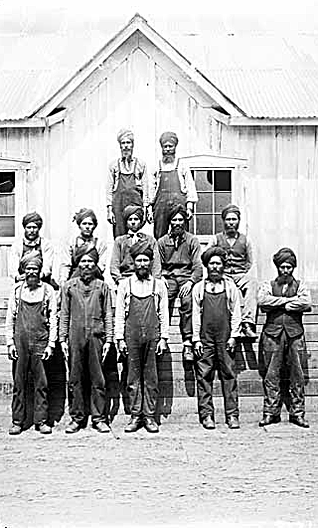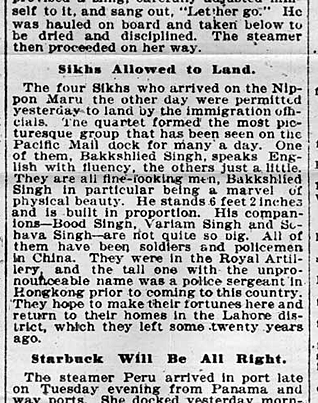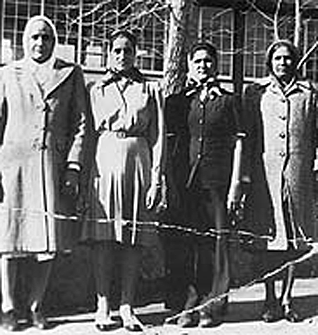
Above: From the painting, "The Pioneer", by R.M. Singh. Below, first from bottom: Sikh-Canadian women pioneers. Second from bottom - a news clipping from the period. Third from bottom - early Sikh-Canadians in Burnaby, British Columbia, Canada.



Books
The Four Quarters of the Night
A Book Review by MANJYOT KAUR
THE FOUR QUARTERS OF THE NIGHT: THE LIFE-JOURNEY OF AN EMIGRANT SIKH, by Tara Singh Bains and Hugh Johnston. McGill-Queen's University Press, Montreal & Kingston, 1995. ISBN 0-7735-1266-7. xviii + 275 pages. Price: US$ 29.95.
After a mellifluous translation of Pahrei ("The Quarters"), composed by Guru Ram Das (GGS pp. 76-7), that gave this work its name, a very brief, but illuminating Foreword by Tara Singh Bains begins this book.
In a mere two paragraphs, suffused with true humility and strength of character, he gives us a look at his core philosophy - the unwavering belief that the Hand of God is fully present in every moment of his existence, shaping all the circumstances and challenges of his life - and expresses his aim of sharing the hard-won lessons he has learned over the years, not for the purposes of self-aggrandizement, but in hopes of guiding others.
Then follows "A Word from the Amanuensis", written by Hugh Johnston, Professor of History at Simon Fraser University in British Columbia, Canada. Given his self-appellation, Johnston evidently shares Tara Singh's sense of modesty.
Far from merely being "one employed to write from dictation", as the word's definition would indicate, this section reveals his collaborative role in the book as going well beyond that of just a recorder fulfilling Tara Singh's didactic purpose, as it outlines his considerable efforts to be an effective guide through "the non-linear pathways of memory".
An insert of fourteen black-and-white photos, portraying Tara Singh at various stages of his life, as well as some of his most personally-significant places, creates a most appropriate atmosphere for delving into the body of the work.
"No roads led from Sarhala Khurd, the village where I was born, only cart tracks".
So begins Tara Singh's story of a place, in the heart of Punjab's Hoshiarpur District, where his family can trace their residence since the time of Maharaja Ranjit Singh.
In 1908, his father emigrates, living on the west coasts of both Canada and the United States, before returning home, in 1919, to his wife and daughter. After four years' time, Tara Singh is born. His mother dies shortly thereafter, and his father does not delay remarriage.
Four more years later, his sister weds a man who has recently established himself in Canada, and moves to her new husband's home in Vancouver. His stepmother and grandmothers are fondly remembered as kindly influences on his early childhood, but he recalls only "what one should not emulate" in his manipulative and dictatorial father. Scenes of horrifically brutal abuse - both physical and verbal - perpetrated by this hulking man with a volcanic temper dominate the initial chapters of this book.
In stark contrast to his father is his first role model, a teacher whom he credits as being "the greatest positive influence in my life".
Halvaldar Khem Singh makes school "a place of openness and appreciation for what you did", and imbues young Tara with strong Sikh faith and a firm sense of dedication to service. Remembering these formative years, he remarks that, through this exemplary educator, "Sikhism entered my mind, became established, and carried on, progressing, shaping, and becoming the fixed point, the axle of my life's vehicle".
Despite his father's enormous demands on his time for work on the family farm (as the eldest son, he rises at 4 a.m. and does two hours of exhausting labor both before and after his five-mile bicycle ride to classes), Tara Singh manages to not only complete his early education, but also graduate from the English-medium Khalsa High School.
Marriage comes while he is still in his teens, to a girl who possesses a rare qualification for females in those days: she has finished primary school and, therefore, is literate. Karam Kaur is described in simple, but loving terms: "She was such a nice person, and the affection that was so abundant in my mind had an outlet at last, and I had a measure of it, for life, to live for".
For a time, their budding love would only be communicated in letters, as the young husband soon joins the army as a "technical storekeeper". His service is described in extremely positive terms:
"Freedom of life, total glow of life, started with my army career. It was total relief and total happiness and relaxation, too. I was by nature a hard worker, God-gifted to perform my duty honestly and to the maximum of my strength".
Reunited with his wife and posted at Rawalpindi, Punjab [now in Pakistan] when India became independent, it is surprising that Partition receives only a fairly brief mention. A daughter is born to the couple during the fateful summer of 1947, and, two years later, a son arrives. Shortly afterward, Tara Singh contracts tuberculosis and is discharged from military service.
In the course of his lengthy convalescence, during which a second son was born, his prayers for a chance to encounter "a holy person" are suddenly answered. While slowly pedaling down a scorched and dusty village path, he has an impromptu crossing with a heavily-laden fellow cyclist, a "majestic elderly man with a flowing white beard, like the picture of Guru Nanak".
Trusting his "heart's voice", he immediately perceives the man's immense sense of spirituality and persuades him to break his journey for several days. The guidance Tara Singh receives from the intense discussions that ensue soon point his life in a new direction: Canada.
In April of 1953, he bids a temporary farewell to Karam Kaur, now expecting their fourth child, and joins his sister and her family on their Vancouver farm.
The happiness he feels at seeing his sister again after three decades of separation and meeting her husband and five sons soon evaporates, as "culture clash" sets in, due to the ways in which they have assimilated into mainstream Canadian society.
"All their talk was aimed at inducing and seducing me to shave. They wished me to change my outer form, which was my God-given form. (...) I never thought it would be my own people who would hate my hair. No white man has done that to me so far".
Adamant that he will never be parted from his keshas, he tells his sister and her family that he would much rather lose his lodgings than his hair. They grudgingly give in to the strength of his heartfelt convictions.
His difficulties are far from over, however.
In the fall of that year, he takes a job in a sawmill at Nanaimo, thus entering the lumber industry that will employ him for the rest of his working life. He immediately faces a host of new problems.
The sawmill owner keeps his shift workers in uninsulated, overcrowded and overpriced housing. He is grossly exploited on the job, receiving abysmal wages and sometimes being forced to work overtime without pay. People jealous of his rising status in the union accuse him of having Communist ties. And, as if that were not enough, he is targeted for proselytization by a group of Christian clergymen.
Through his unshakeable faith in God and natural tenacity, he manages to persevere. His long years of community service begin, as he actively participates in the fight for equal rights of East Indian immigrants with their European counterparts, and is elected to office in the Canadian East Indian Welfare Society. He is eventually promoted to lumber grader.
He joins the Canadian Legion and cements warm friendships with non-Sikh union members. As immigration quotas ease somewhat, he sponsors entry into Canada for two of his brothers.
His life is destined to take another turn in mid-1960: his wife, daughter and middle son become seriously sick with typhoid fever. He takes their illnesses as a "command from God" to quit his job and return to India.
As his family slowly returns to health, he becomes re-immersed in Punjabi rural life. His standing in the community boosted by his status as a returnee from Canada, he joins the village panchayat in their projects: school improvement, paving the dirt roads, constructing a long-needed drainage system.
The family's fifth and last child, a second daughter, is born. Suitable marriages are arranged for the eldest two children.
During the summer of 1966, in a reversal of the family situation that resulted in his return to India, his Vancouver-based younger brother's desperate need for a kidney transplant takes him back to British Columbia. His reintegration into North American life is relatively smooth: he gets a job as an export lumber grader, buys a car and a house in the town of Richmond and becomes active in the local gurdwara.
Getting landed immigrant status becomes easier in the late 1960s and early 1970s than ever before. Visitors could come to Canada and apply for permanent residence after they arrived, and it wasn't long before almost every Sikh family had relatives from India staying with them.
Tara Singh proves no exception to this. At the end of 1968, his eldest son and daughter-in-law join him. In the summer of 1971, his wife and their remaining four children and son-in-law emigrate, reuniting the family.
His growing involvement in gurdwara management activities makes him realize what he terms the "barren" state of Sikh religious observance: "These people were born into Sikh families, but they were not practicing Sikhs. (...) They were just carrying on religious performances on a routine basis. Such was their knowledge of Sikhism that they had started calling me Giani Ji, a scholar, when I was at grade one compared with what is required".
Many congregants not only no longer maintain unshorn hair and beards, but also insist on attending services bareheaded. When construction of a new gurdwara begins, a basement level is planned for parties and dancing, a cafeteria-style langar hall is envisioned, and no place is set aside to erect a flagpole for the Nishan Sahib. His dismay peaks when matters hit too close to home: one of his sons and his son-in-law, despite solemn promises taken before Guru Granth to "maintain their full form", cut their hair and shave their beards.
The rest of the 1970s brings other changes to Tara Singh's life, as well. His younger children are beginning to attend university and think about getting married. In 1973, a back injury forces him to retire from the sawmills. In 1976, with his disability exacerbated by the cold winters, he and his wife decide to move back to her natal village in India.
By the end of the decade, however, they return to British Columbia. A recurrent pattern of back-and-forth relocation begins, which will end up spanning the remainder of the time period covered by the book. While the climate of Punjab seems to ease his physical problems and he enjoys becoming increasingly active in service projects in his wife's village and environs, happenings with his children (including the traumatic divorce of his younger daughter) and Canadian-based siblings repeatedly necessitate his return to the family home in Richmond.
While it is evident throughout this entire work that Tara Singh's life has always fully incorporated the teachings of Sikhi, the last chapter, "Following Sikh Discipline", still comes as a welcome addition.
He describes his personal devotional practice, which allots large amounts of time to Naam Simran and recitation of Gurbani. For him, the "mirror of prayer" is essential for self-introspection and extirpation of "the vice within ... that keeps us away from absorption into the universality of the Almighty".
Not surprisingly, he puts enormous emphasis on traditional family values. But, keeping his own father in mind as a negative example, he is no despot: gentle guidance, mutual accomodation between parents and children and "open family durbars" stressing frank and repercussion-free dialogue are given great importance.
He also puts forth his standpoint on other matters of Sikh significance, giving his views on what it means to be a Khalsa, criticizing various practices of the SGPC, and expressing his opinions on the nature of Khalistan.
A very illuminating and insightful "Postscript by the Amanuensis" is the first of three concluding sections. In it, Johnston describes the efforts by which he and Tara Singh created the book, and convincingly demonstrates the admirable degree to which he has immersed himself in Punjabi culture and become educated about the Sikh-Canadian experience.
In 1983, Tara Singh and Hugh Johnston meet for the first time. For Johnston, "a casual interest in an exotic culture at my doorstep" had already deepened greatly, while writing a book about the early history of Sikhs in Canada and pursuing a research fellowship in Punjab.
When an idea about presenting the life history of an individual member of the Sikh community surfaces, it is natural for him to think first of Tara Singh: "I knew he was a practicing Sikh whom Sikhs respected, that he had been active in Sikh organizations, and that he was a man of strong convictions. (...) He is an Amritdhari Sikh with full hair and beard and I wanted that perspective".
In 1987, Johnston asks Singh if he would be willing to share the lessons of his life. In the latter's view, this offer is no accident. He immediately replies: "God has brought us together to do this", and expresses his longtime desire to participate in such a collaboration.
The last two parts of the book comprise "Suggestions for Further Reading" (an excellent annotated bibliography) and a remarkably lengthy glossary of Punjabi vocabulary.
I found Tara Singh's "life-journey" to be a powerful and inspiring one. The refreshing quality of transparent honesty he evinces when describing his thoughts and motives is quite admirable. Equally so are the ways he seamlessly combines genuine humility with a strong self-image. Even under the most adverse of circumstances, he not only resists descending into bitterness and self-pity, but also steadfastly refuses to compromise his profoundly-cherished Sikh faith, his tightly-held principles, and his clearly-defined sense of personal integrity.
While he constantly bears in mind, "I am nothing at all; it is all Him", he also realizes the value of being true to himself and his convictions and the necessity of going forth to take forceful and decisive action when events demand it.
Hugh Johnston's handling of his role in creating this book is most commendable. While it is very clearly the result of intensive collaboration, his transformative hand is a light and delicate one, never intrusive or obfuscating. The ways in which he gives shape to Tara Singh's lifetime of memories are highly adroit.
In addition, his prefatory and concluding "Amanuensis" chapters frame the body of the work in a very cogent and cohesive way, without falling back upon the academic jargon beloved by so many denizens of "the ivory towers".
It must nevertheless be said that this book does have a few faults. Some of Tara Singh's recollections, fascinating though they may be, are just a bit too intricately complicated and long-winded, and would have greatly benefited from some judicious streamlining. There is one glaring error: during a discussion of the caste system in Punjab, Chamars (traditionally, leatherworkers) are characterized as Ramdasias, rather than Ravidasias.
Furthermore, a computer glitch, explained in an inserted errata slip, mars the otherwise very valuable glossary: all the long vowels of the Punjabi words have failed to print (for example, "Akali" appears as "Ak l "). It should be noted that, along with an apology, an address is given from which a befuddled reader can request a corrected version of these pages.
However, these shortcomings do not detract from what is clearly a most valuable piece of writing. As Johnston explains, an in-depth personal document like this is quite rare. The same themes also appear in larger and more objective studies; here, though, they are placed within a individual context that retains the subtleties a more abstract and comprehensive work cannot easily capture.
Therefore, this book is much more than one man's autobiography. Tara Singh's single voice reveals much about the collective experience of immigration. Finding a sense of personal harmony and balance, while exploring ways by which one might adopt one country and culture without abandoning another, is certainly something all immigrants, regardless of ethnic origin and destination, can identify with.
This is also true with reference to the ways in which he attempts to successfully juggle spiritual life, family life, working life, and community life - all while shuttling back and forth between two very disparate continents.
The Four Quarters of the Night is evocative and appealing, highly recommended for Sikhs and non-Sikhs (both young and not-so-young) of all ethnic and national backgrounds!
[The first and third photos from the bottom, on the right, are published, courtesy - Sarjeet Singh Jagpal, "BECOMING CANADIANS".]
[January 27, 2008]
Conversation about this article
1: Inni Kaur (Fairfield, CT, U.S.A.), January 28, 2008, 8:01 AM.
Manjyot, what a wonderful review. I have read this book twice. However, your review has rekindled the desire for another read. Many thanks!
2: Amrik Singh (New Delhi, India), January 29, 2008, 12:46 PM.
This sounds like the kind of book that needs to be written (dictated?) in every part of the Sikh diaspora. This constitutes history at its best ... raw, unadulterated and real! I've already sent for my copy. Many thanks, Manjyot ji, for introducing us to yet another treasure.
3: Roshan Kaur (Oakville, Ontario, Canada), January 29, 2008, 12:49 PM.
Surely, some enterprising filmmaker or TV executive will see an epic movie or TV series in this simple, yet extraordinary, story that spans a century and continents.
4: Mahinder Kaur Doman (Victoria, British Columbia, Canada), February 07, 2008, 2:47 AM.
The photo of the men/Gurdwara is a common photo one in many British Columbia Sikh homes of pioneer immigrant descendants. Mr. Johnston apparently sold the rights to a previous book on Komogata Maru, for a movie. In British Columbia, there has been discussion about the information bought for this project. I further understand that the movie project has been shelved by the producers. The books written by non-Indians and post 1960's Indians eager to tell the story of pioneer Sikh immigrants to Canada without proper research is disturbing to families of pioneer Sikh immigrants who know the REAL stories. An upcoming publication scheduled for later this year will tell some of their stories.
5: Swarn Singh Kahlon (Chandigarh, India), February 12, 2008, 11:27 AM.
I had heard about the book but now I know the theme in summary form - it's very powerful. Stories of immigrants are fascinating.
6: Parkash Kaur Athwal (Delta, British Columbia, Canada), August 19, 2008, 3:08 PM.
Manjyot ji, thank you for such a wonderful and very objective review of this book. I am the youngest daughter of Tara Singh. My father passed away in 2003 on one of his sojourns back to India. Your review has created a yearning to read the book again. The emotional pain of losing my parents has prevented me from picking it up again. Thank you.
7: Sandeep (Charlotte, U.S.A.), February 16, 2009, 5:15 PM.
I liked it very much. I am interested to know more about his life, after the last chapter of his book, which takes us to 2003. Is there any information about him? [Editor: The only further information we have is that he passed away not long thereafter.]


